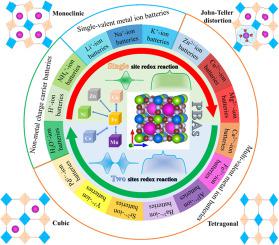Nano Energy ( IF 16.8 ) Pub Date : 2020-11-24 , DOI: 10.1016/j.nanoen.2020.105632 Longtao Ma , Huilin Cui , Shengmei Chen , Xinliang Li , Binbin Dong , Chunyi Zhi

|
Prussian blue analogs (PBAs) that can host almost all ions having been used in and potentially utilized in batteries, have been proposed as electrode materials for the largest variety of rechargeable batteries including single-valent (Li+, Na+, K+), multivalent (Zn2+, Cu2+, Fe2+, Mg2+, Ca2+, Sr2+, Ba2+, Pd2+, Al3+, Y3+) metal ion batteries and even non-metal charge carrier (H+, NH4+, H3O+) batteries. On the other hand, PBAs with three-dimensional open framework can provide highly reversible insertion/removal of ions in both aqueous and non-aqueous electrolytes. What is more, PBAs possess two active redox species for redox reactions during electrochemical charge/discharge process, potentially providing high specific capacity for batteries. However, in most cases, only one transition-metal specie is activated during charge/discharge process, together with existence of vacancies and coordinated/interstitial water molecular, leading to 50% lower electrochemical utilization of PBAs framework. In this review, we present a comprehensive overview on electrochemical redox of PBAs hosting Li+, Na+, K+, Zn2+, Cu2+, Fe2+, Mg2+, Ca2+, Sr2+, Ba2+, Pd2+, Al3+, Y3+, H+, H3O+ and NH4+ ions for rechargeable batteries, including number of redox active species, structural evolutions, output voltage, capacity delivered and cyclic stability. We also analyze the strategies and progresses in overcoming issues associated with achieving high specific capacity, high output voltage and long cyclic lifespan of batteries based on PBAs cathodes. Finally, perspectives are provided on the design requirements for future generation of PBAs electrodes, with focus on synthetic strategies, structure design, electrolyte optimization and electrochemical principle towards large-scale electric application.
中文翻译:

在可充电电池的普鲁士蓝类似物框架中容纳各种离子:电化学氧化还原反应
普鲁士蓝类似物(PBA)可以容纳几乎所有已在电池中使用并可能在电池中使用的离子,已被提议作为包括单价(Li +,Na +,K +),多价(Zn 2 +,Cu 2 +,Fe 2 +,Mg 2 +,Ca 2 +,Sr 2 +,Ba 2 +,Pd 2 +,Al 3+,Y 3+)金属离子电池,甚至是非金属载流子(H +,NH 4 +,H 3 O +)电池。另一方面,具有三维开放框架的PBA可以在水和非水电解质中提供高度可逆的离子插入/去除。此外,PBA具有两种活性氧化还原物质,可在电化学充电/放电过程中进行氧化还原反应,从而有可能为电池提供高比容量。然而,在大多数情况下,在充电/放电过程中只有一种过渡金属物种被激活,同时存在空位和配位/间隙水分子,导致PBAs骨架的电化学利用率降低了50%。在这篇综述中,我们提供了有关承载Li +,Na +,K +,Zn 2 +,Cu 2+的PBA的电化学氧化还原的全面概述,Fe 2 +,Mg 2 +,Ca 2 +,Sr 2 +,Ba 2 +,Pd 2 +,Al 3+,Y 3+,H +,H 3 O +和NH 4 +用于可充电电池的离子,包括氧化还原活性物质的数量,结构演变,输出电压,输送的容量和循环稳定性。我们还分析了解决与基于PBA阴极的电池实现高比容量,高输出电压和长循环寿命相关的问题的策略和进展。最后,对下一代PBA电极的设计要求提供了观点,重点是合成策略,结构设计,电解质优化和面向大规模电应用的电化学原理。











































 京公网安备 11010802027423号
京公网安备 11010802027423号